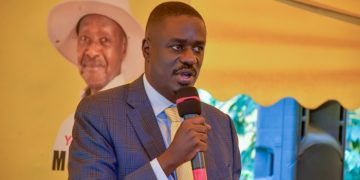The National coordinator of the Parish Development Model (PDM), Hon Dennis Galabuzi Ssozi, has revealed that the government flagship programme of PDM is meant for only 39 percent of Ugandans who are living a subsistence life to enable them to get involved in the cash economy.
Galabuzi made the remarks on Thursday, 17, at the NRM secretariat in a weekly ideological clinic where he was invited to enlighten Ugandans on the PDM mode of operation.
Galabuzi said, “We all have people in our communities who are working for only the stomach, these are the people we are targeting and they are 39% of Ugandans. The common person at the grass-root who has not been involved in the money economy.”
He noted that government has tried several programs to uplift the living standards of Ugandans but it has failed due to many factors like technocrats corruption, politicking, failure to pay back the revolving loans among others, saying that PDM has come with a hindsight to tackle all the bottlenecks.
“There have been very many interventions to eradicate poverty, some have not performed to the expectations. But for PDM we have come with hindsight based on the challenges we faced before. The challenge is that people are centralizing politics on the issue of PDM. I request everyone to appreciate the concept and we all move in one direction,” Galabuzi noted.
The former State Minister for the Luwero Triangle, emphasized that this time the government is going to release money directly from the top to parish-based SACCOs such that it can be well monitored by parish chiefs. He said that this is done to remove bureaucracy where money can get lost as has been the case before.
Derived from one of NRM’s core ideological principles of socio-economic transformation, PDM, Galabuzi says, is a a programme every leader must be interested in.
“This programme deals with solving problems faced within our societies. As a leader, your legacy is built on changing the lives of your people,” he noted.
On the issue of youth inclusion in the money economy to eliminate high levels of unemployment, the former legislator says that there’s a quota of 30% for the youth on PDM funds that is sent at the parish.
PDM was launched on Feb 26, 2022, in Kibuku district, Bukedi sub-region, by its chief proponent, President Yoweri Museveni as a government flagship programme geared to wealth creation and poverty eradication among Ugandans.
Derived from the Lugwere phrase “abakorela ekida kyonka,” a local language in Kibuku which means “working for the stomach only”, the PDM aims at ending poverty amongst 39% Ugandans, not in the Money economy. It is a development approach conceived under the third National Development Plan (NDP III) and prescribed by the NRM Manifesto 2021-2026.
It is structured to boost wealth creation opportunities and to turn every parish in the country into a model development unit. PDM, unlike other government poverty eradication programmes, places the economic power in the hands of communities in real terms. It also offers decision-making in the hands of beneficiaries who will decide what suits them best in their locality.
Financial inclusion (pillar number three) will promote savings and investment by households in the most viable activities with a potential for generating a production surplus for home and local consumption, and the market.
The Model positions the “Parish” as the epicentre and reference unit for planning, implementation, supervision and accountability to drive socio-economic transformation.
At the launch in Kibuku, 10,594 parish SACCOs were launched. These SACCOS are avenues through which people will be able to obtain financing. For starters, each parish will get a revolving fund of Shs17m. Residents will constitute themselves in a format that best fits their development and economic needs based on their unique circumstances.
The Model is designed under seven pillars which include Production, Storage, Processing and Marketing; Infrastructure and Economic Services; Financial Inclusion; Social Services; Mindset change; Parish Based Management Information System; Governance and Administration.








